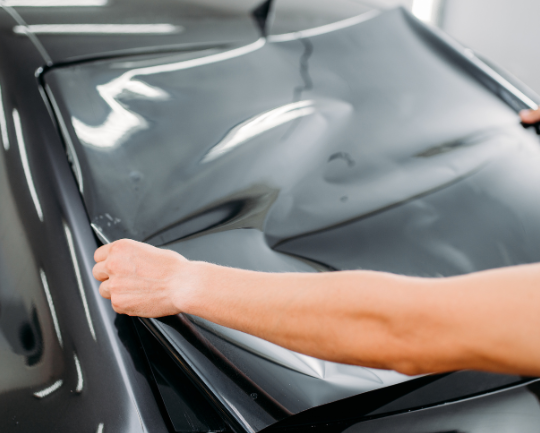The Impact Of Window Tint On Interior Temperature
Window tinting has become more than just a stylish addition to cars and buildings; it’s a practical solution to combat the effects of heat and glare. Whether you’re driving in scorching summer temperatures or trying to maintain a comfortable indoor environment, window tint can make a significant difference. In this blog post, we’ll delve into the impact of window tint on interior temperature, exploring how this simple addition can help keep you cool and comfortable.
Imagine stepping into your car on a hot summer day. The sun is beating down, turning your vehicle into an oven. Now, picture the same scenario, but this time, your windows are tinted. The difference is remarkable. With window tint, the interior of your car remains significantly cooler, making your drive more pleasant and reducing the need for excessive air conditioning.
Window tint works by blocking a portion of the sun’s heat and UV rays from entering your vehicle or building. This not only helps regulate the temperature but also protects your skin and upholstery from sun damage. Additionally, tinted windows can reduce glare, making it easier and safer to drive, especially during bright, sunny days.
In the following sections, we’ll explore how window tint works, its effects on interior temperature, and practical tips for choosing the right tint for your needs. Join us as we uncover the science behind window tint and its impact on creating a more comfortable environment for you and your passengers.
Understanding Window Tint
Window tint is a thin, multi-layered film that is applied to the interior surface of windows in vehicles, homes, and buildings. It is primarily used to reduce the amount of sunlight, heat, and UV rays that enter through the windows. Window tinting has become increasingly popular due to its many benefits, including improved comfort, increased privacy, and protection against UV radiation.
There are several types of window tint available, each with its own set of characteristics and benefits. Dyed film is the most common type and is known for its ability to absorb heat and reduce glare. Metallic film contains tiny metallic particles that reflect heat and UV rays, making it highly effective at reducing heat buildup in a vehicle or building. Ceramic film is the most advanced type of window tint and offers superior heat rejection and UV protection without interfering with electronic devices.
Window tint works by blocking or reflecting sunlight, which reduces the amount of heat that is transmitted through the glass. This helps to keep the interior of a vehicle or building cooler, especially during hot summer months. Additionally, window tint can help to reduce the fading of interior furnishings and upholstery caused by UV radiation.
How Window Tint Works
Window tint works by reducing the transmission of solar radiation through windows, which helps regulate the amount of heat and light that enters a vehicle or building. This is achieved through the use of window films, which are applied to the interior surface of the glass.
- Solar Energy Absorption: Window tint absorbs a portion of the solar energy that strikes the glass, preventing it from entering the interior. This absorption process helps reduce the amount of heat that is transferred into the vehicle or building.
- Reflection: Window tint also reflects a portion of the solar radiation, further reducing the amount of heat and light that enters the interior. This reflective property is especially beneficial in reducing glare and improving visibility.
- Thermal Insulation: Some types of window tint provide thermal insulation by trapping a layer of air between the film and the glass. This air acts as an insulating barrier, reducing heat transfer through the window.
- UV Protection: Window tint blocks a significant portion of harmful ultraviolet (UV) rays from entering the interior. This helps protect the occupants and interior materials from UV damage, such as fading and cracking.
- Visible Light Transmission: Window tint can also control the amount of visible light that passes through the glass. By reducing visible light transmission, tinted windows can help create a more comfortable interior environment with reduced glare and improved privacy.
Overall, window tint works by combining these mechanisms to reduce heat gain, control light transmission, and provide UV protection, resulting in a more comfortable and energy-efficient interior environment.
Effects On Interior Temperature
Window tinting can have a significant impact on the interior temperature of a vehicle or building by reducing heat gain from sunlight. This reduction in heat gain can lead to a cooler and more comfortable interior environment, especially during hot weather. The effects of window tint on interior temperature can be observed in several ways:
- Heat Reduction: Window tinting helps to block a significant amount of the sun’s heat from entering through the windows. This can lead to a noticeable decrease in the temperature inside the vehicle or building, particularly in areas exposed to direct sunlight.
- Temperature Regulation: By reducing the amount of heat that enters through the windows, window tinting can help to regulate the temperature inside the vehicle or building. This can lead to a more consistent and comfortable interior temperature, reducing the need for additional heating or cooling.
- Energy Savings: Window tinting can also help to reduce the load on air conditioning systems, leading to potential energy savings. By reducing the amount of heat that enters through the windows, window tinting can help to maintain a more stable interior temperature without the need for excessive use of air conditioning.
- UV Protection: In addition to reducing heat gain, window tinting also helps to block harmful UV rays from entering through the windows. This can help to protect the interior of the vehicle or building from sun damage and fading, as well as reduce the risk of skin damage from UV exposure.
- Comfort Improvement: By reducing the amount of heat that enters through the windows, window tinting can help to create a more comfortable interior environment. This can lead to a more pleasant driving or living experience, especially during hot weather.
Overall, the effects of window tint on interior temperature can be significant, leading to a cooler, more comfortable, and more energy-efficient interior environment.
 Factors Affecting Performance
Factors Affecting Performance
- Tint Quality and Installation: The quality of the window tint material and the skill of the installer can significantly impact its performance. High-quality tints are more durable and effective in reducing heat transfer.
- Tint Darkness and Composition: The darkness or shade of the tint affects its ability to block heat and light. Generally, darker tints offer better heat reduction but may not be legal in all areas. The composition of the tint, such as dyed, metallic, or ceramic, also influences its heat-blocking properties.
- Climate and Sun Exposure: The climate and amount of sun exposure in your area can impact how much heat enters through the windows. Areas with hot climates and prolonged sun exposure may benefit more from window tinting.
- Window Type and Size: The type of windows you have (e.g., single-pane, double-pane) and their size can affect how much heat they transfer. Larger windows and single-pane glass tend to allow more heat to pass through.
- Tint Maintenance: Proper maintenance of the window tint, including cleaning and care, can ensure its effectiveness over time. Damaged or deteriorated tint may not perform as well in reducing heat transfer.
- Regulations and Restrictions: Local regulations and restrictions regarding the darkness and type of window tint allowed can also affect its performance. It’s important to comply with these regulations to avoid legal issues.
Practical Tips
- Choose the Right Tint: Opt for a high-quality window tint that offers good heat reduction properties. Consider ceramic or infrared rejecting films for maximum heat rejection.
- Consider Tint Darkness: Darker tints can offer more heat reduction but may also reduce visibility. Check local regulations regarding tint darkness limits.
- Ensure Proper Installation: Proper installation is crucial for the effectiveness of the tint. Hire a professional installer to avoid issues such as bubbling or peeling, which can reduce the tint’s effectiveness.
- Maintain Your Tint: Regularly clean your tinted windows using a mild detergent and a soft cloth. Avoid using abrasive cleaners or rough materials that could damage the tint.
- Use Sunshades or Visors: Use sunshades or visors when parking your vehicle to further reduce heat buildup inside.
- Park in the Shade: Whenever possible, park your vehicle in a shaded area to reduce the amount of direct sunlight and heat entering through the windows.
- Consider Window Treatments: In addition to tinting, consider other window treatments such as reflective films or blinds to further reduce heat gain.
- Monitor Interior Temperature: Use a thermometer to monitor the interior temperature of your vehicle or building before and after tint installation to gauge the effectiveness of the tint.
- Be Aware of Tint Laws: Familiarize yourself with local laws and regulations regarding window tinting to ensure compliance and avoid potential fines or penalties.
Implementing these tips can help you maximize the benefits of window tinting in reducing interior temperature and improving overall comfort.
Window tinting can have a significant impact on the interior temperature of vehicles and buildings, providing a cooler and more comfortable environment. By reducing heat gain and blocking harmful UV rays, window tinting not only enhances comfort but also helps save on energy costs. Choosing the right tint and ensuring proper installation are key factors in maximizing these benefits.
If you’re considering window tinting for your vehicle or building, take the time to research the different types of tint available and their heat reduction properties. Consult with a professional tint installer to determine the best tint for your needs and ensure proper installation. By investing in window tinting, you can enjoy a cooler interior, lower energy bills, and a more comfortable environment.




